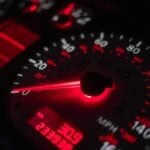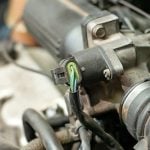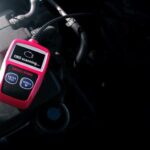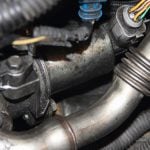Engine misfiring while driving can be quite annoying. But, what will you do if you get a warning of a low fuel tank? It won’t be very clear for you! It implies that your car encountered the diagnostic trouble code (DTC) P0313. Is the P0313 code very serious?
The powertrain control module (PCM) activates an indicator light to notify the driver of low fuel levels. The warning for a low fuel tank shows up when only one to three gallons of petrol remain in the tank. As a result, the engine may misfire due to low fuel levels, resulting in this diagnostic code.
Numerous factors can cause this, so a technician must identify the precise cause in your case to clear the code. So, what are the causes and symptoms of the P0313 code? Then, how can you repair it? Know all about this DTC and how to clear it!
What does the P0313 code mean?
The code implies ‘Misfire Detected With Low Fuel.’ It is a standard OBD-II fault code that appears in the PCM.
When the PCM determines that a lean air-to-fuel mixture is the primary cause of the engine misfire, onboard diagnostics (OBD) can record a P0313 code. A lean state might develop if there isn’t enough fuel and the fuel pump gets exposed. The PCM will record a P0313 code whenever the fuel pump cannot take up the remaining fuel.
Depending on the car manufacturer, the definition of the code may vary. Therefore, you must consult the relevant repair manual or database for the precise code definition.
How serious is the P0313 code?
The code can pose a serious concern if the engine runs out of fuel. You can get stuck somewhere and need help or a tow to get out of it. However, the DTC is frequently less significant when activated for another reason. A misfire can result in low fuel efficiency, increased emissions, and a rough-running engine. Still, often it won’t affect the engine’s ability to function reliably.
Can I drive with a P0313 code?
It is better not to drive if the code activates with a warning of a low fuel tank. However, the code won’t pose a serious issue if activated for another cause. Whatever the cause is, you should diagnose the issue and clear the code as soon as possible.
What causes a P0313 code?
These are some factors that can cause the code to activate.
- The fuel pump isn’t supplying enough fuel to operate effectively, and the fuel tank is running low on fuel.
- The failure of one or more ignition coils prevents the appropriate cylinders from igniting.
- When spark plugs get fouled, they barely produce any spark in the cylinder.
- A faulty fuel injector pumps too much fuel into the cylinder.
- There’s an internal issue with the engine control module.
- The car owner’s driving habits.
- Presence of damaged wires or poor connections in the circuit.
- A faulty PCM.
- The fuel filter gets blocked.
What are the symptoms of the P0313 code?
These are the common symptoms that you can observe when the code activates.
- Indication of low fuel.
- The Check Engine Light illuminates.
- Engine performance goes down.
- There will be hesitation while accelerating the car.
- The car will show a hard or no-start condition.
- There will be a loss of power.
How to diagnose the P0313 code
Ensure your car has a fully charged battery; if it isn’t, charge it. Then, after driving the vehicle 20 to 40 miles, check to see if any codes that were only there due to low gas to the fuel pump for troubleshooting are still present. Check for power in each wire from the crank connector to the ECU. You must do this if the low fuel warning light did not show when you turned on the ignition. If the code reappears, the fuel pump is not the source of your car’s issue.
How do I fix the P0313 code?
The process might be challenging and irritating if you don’t know how to fix a P0313 error and don’t have the necessary equipment. You can take your car to the nearby repair shop and have a mechanic handle the work for you if you’re not yet confident in your DIY abilities. If you want to diagnose and fix this issue code on your own, be sure to use a reliable repair manual.
How does a mechanic diagnose code P0313?
A mechanic uses an OBD-II scanner to identify the code. The mechanic might be able to erase the fault code if it is stored or inactive. After being cleared, you should drive the car to ensure the situation has vanished. Then check for the code again to ensure they aren’t pending or set again. A mechanic will perform the following steps if the code returns.
Steps they will follow
- The initial step is to fill the fuel tank. This simple action can clear up the issue if the code is related to a low fuel level.
- A mechanic will continue to identify the issue by inspecting connections to the troubled cylinder, even with an overfilled gasoline tank. Typically, there will also be a misfire for a particular cylinder.
- The mechanic can ensure that the locking tabs are inserted appropriately on the ignition coil connector, fuel injector connector, and ignition wires.
- They will inspect the wiring for breaks, corrosion, and shorts to the ground.
- If the issue persists, the mechanic could start switching out system parts with another cylinder to determine which one is broken. They will know which component to repair if the DTC tracks a component to a different cylinder.
Common mistakes made while diagnosing the code
The most frequent error made when diagnosing the P0313 code is failing first to fill the fuel tank. Low gasoline levels frequently result in inadequate fuel flow to the engine as the cause. Otherwise, a misdiagnosis can happen if the mechanic replaces parts without a thorough diagnosis.
What repairs can fix the P0313 code?
These are common repairs you can do if your car encounters the error code.
- Fill the fuel tank again. If low fuel levels cause the problem, the symptoms will disappear, and you need to clear the DTC alone.
- Replace the ignition cables or coils. After isolating the specific component, you can install a new one in its place.
- Clean the fuel injectors. Cleaning the injectors can solve the problem if the code results from subpar fuel injection. Also, you can get new ones if the old ones become broken.
- Switch out the spark plugs. Fouled spark plugs may occasionally bring on a misfire code or worn spark plug electrodes in cold weather.

Gerard Stevens is an experienced writer specializing in travel and car ownership in the U.S. With over five years in this field, he strives to simplify travel and driving for his readers. Gerard offers valuable guidance on various topics, including car and travel guides, helping his audience feel more confident in navigating these challenges.



















